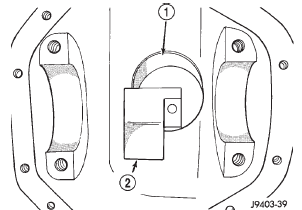Jeep Cherokee (XJ): 181 FBI pinion gear depth
GENERAL INFORMATION
Ring and pinion gears are supplied as matched sets only. The identifying numbers for the ring and pinion gear are etched into the face of each gear (Fig.
71). A plus (+) number, minus (-) number or zero (0) is etched into the face of the pinion gear. This number is the amount (in thousandths of an inch) the depth varies from the standard depth setting of a pinion etched with a (0). The standard setting from the center line of the ring gear to the back face of the pinion is 92.08 mm (3.625 in.). The standard depth provides the best gear tooth contact pattern. Refer to Backlash and Contact Pattern Analysis paragraph in this section for additional information.

Fig. 71 Pinion Gear ID Numbers
1 - PRODUCTION NUMBERS
2 - DRIVE PINION GEAR DEPTH VARIANCE
3 - GEAR MATCHING NUMBER (SAME AS RING GEAR
NUMBER)
Compensation for pinion depth variance is achieved with a select shim/oil baffle. The shims are placed between the rear pinion bearing and the pinion gear head (Fig. 72).

Fig. 72 Shim Locations
1 - PINION GEAR DEPTH SHIM/OIL BAFFLE
2 - DIFFERENTIAL BEARING SHIM
If a new gear set is being installed, note the depth variance etched into both the original and replacement pinion. Add or subtract this number from the thickness of the original depth shim/oil slinger to compensate for the difference in the depth variances.
Refer to the Depth Variance chart.
Note where Old and New Pinion Marking columns intersect. Intersecting figure represents plus or minus the amount needed.
Note the etched number on the face of the pinion gear head (-1, -2, 0, +1, +2, etc.). The numbers represent thousands of an inch deviation from the standard.
If the number is negative, add that value to the required thickness of the depth shims. If the number is positive, subtract that value from the thickness of the depth shim. If the number is 0 no change is necessary.
PINION GEAR DEPTH VARIANCE

PINION DEPTH MEASUREMENT AND ADJUSTMENT
Measurements are taken with pinion bearing cups and pinion bearings installed in the axle housing.
Take measurements with Pinion Gauge Set and Dial Indicator C-3339 (Fig. 73).

Fig. 73 Pinion Gear Depth Gauge Tools-Typical
1 - DIAL INDICATOR
2 - ARBOR
3 - PINION HEIGHT BLOCK
4 - CONE
5 - SCREW
6 - PINION BLOCK
7 - SCOOTER BLOCK
8 - ARBOR DISC
(1) Assemble Pinion Height Block 6739, Pinion Block 6733, and rear pinion bearing onto Screw 6741 (Fig. 73).
(2) Insert assembled height gauge components, rear bearing and screw into axle housing through pinion bearing cups (Fig. 74).
(3) Install front pinion bearing and Cone-nut 6740 hand tight (Fig. 73).

Fig. 74 Pinion Height Block-Typical
1 - PINION BLOCK
2 - PINION HEIGHT BLOCK
(4) Place Arbor Disc 6732 on Arbor D-115-3 in position in axle housing side bearing cradles (Fig. 75).
Install differential bearing caps on Arbor Discs and tighten cap bolts to 41 N·m (30 ft. lbs.).
NOTE: Arbor Discs 6732 has different step diameters to fit other axles. Choose proper step for axle being serviced.
(5) Assemble Dial Indicator C-3339 into Scooter Block D-115-2 and secure set screw.
(6) Place Scooter Block/Dial Indicator in position in axle housing so dial probe and scooter block are flush against the rearward surface of the pinion height block (Fig. 73). Hold scooter block in place and zero the dial indicator face to the pointer. Tighten dial indicator face lock screw

Fig. 75 Gauge Tools In Housing-Typical
1 - ARBOR DISC
2 - PINION BLOCK
3 - ARBOR
4 - PINION HEIGHT BLOCK
(7) With scooter block still in position against the pinion height block, slowly slide the dial indicator probe over the edge of the pinion height block.
(8) Slide the dial indicator probe across the gap between the pinion height block and the arbor bar with the scooter block against the pinion height block (Fig. 76). When the dial probe contacts the arbor bar, the dial pointer will turn clockwise. Bring dial pointer back to zero against the arbor bar, do not turn dial face. Continue moving the dial probe to the crest of the arbor bar and record the highest reading.
If the dial indicator can not achieve the zero reading, the rear bearing cup or the pinion depth gauge set is not installed correctly.
(9) Select a shim/oil baffle equal to the dial indicator reading plus the pinion depth variance number etched in the face of the pinion (Fig. 71). For example, if the depth variance is -2, add +0.002 in. to the dial indicator reading.
 Disassembly and assembly. Cleaning and inspection
Disassembly and assembly. Cleaning and inspection
Other materials:
Body decals
Small nicks, scratches and other surface marks in
a decal can be touched-up with paint.
To eliminate blisters and air bubbles in a decal,
pierce them with a needle or pin.
A heat gun can also be used to remove small wrinkles
in a decal.
Decal replacement requires that the metal repair
a ...

